You might be stupid. A moron. An idiot. A fool. A babbling unintelligent chimp with the IQ of a sack of hammers. But if you are a good chess player, then people will still think that you're smart. Along with nuclear physicists and brain surgeons, great chess players are seen as being among the intellectual giants of the planet. This is partly because chess involves the simultaneous use of strategy, mathematics, and risk-analysis, and partly because the game is such a bitch to learn. But fear the chessboard no more, for we will now teach you the basics of chess. No, we won't teach you enough to start scamming people in Central Park, but you'll at least be able to follow the game and make witty comments.
We're first gonna teach you how to set everything up and know how everything moves before we even mention anything about strategy. But just so that you can keep it in mind, the piece called the "king" is the most important piece. The goal of the game is to capture your opponent's king before your opponent captures yours. All of the rest is just details. Your king is all that matters. Long live the king!
If you can't wait to plan your hostile takeover, save some time and view this video, which will have you dethroning your opponent in no time.
WATCH THIS HOW-TO VIDEO
1. SET UP THE PIECES PROPERLY
A chess game involves two people sitting on opposite sides of a chessboard. A chess board looks exactly like a checkerboard. But it's not a checkerboard. It's a chessboard. If you don't use the proper terminology, we can just stop right now and you can go back to your pathetic chess-less life.Still here? Good. First, put the board down between you and your opponent. Just for the sake of simplicity, let's name your opponent Moe. We want to start you off easy. In any case, feel free to replace the word "Moe" with "Larry," "Curly" or "Shemp," if it so suits you.
Anyway, put the chessboard between you and Moe so that the white square at the bottom is to your right. You can remember this by using the catchy phrase "Right is white."
Each player has 6 different types of chess pieces: there are 8 pawns, 2 rooks, 2 knights, 2 bishops, 1 queen, and 1 king. The pawns are the smallest pieces, and you will recognize them because (duh) there are eight of them. The rooks look like tiny little castles with jagged edges along the top. The knights look like little horse heads. The bishops are the things with little balls on the top (they look like Sesame Street's Grover looking up). The king is the tallest piece and has a cross on top. The last piece is the queen, which is the 2nd tallest piece and has a little crown around the top.
Here's a picture:
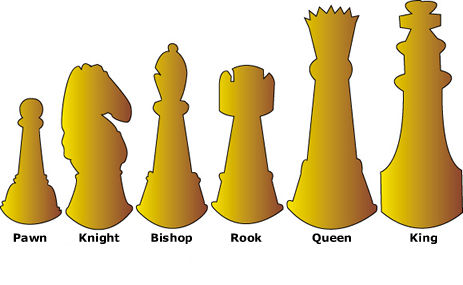
Now, one player will be the white pieces, and one will be the black pieces. The way to decide is for you to put a pawn in each hand (black in one, white in the other), switch ‘em around behind your back, and then have Moe pick a hand. Whichever color pawn Moe picks, that's the color he'll be for the game. This might seem like a useless detail, but it's actually very important. This is because whoever is white always makes the first move of the game.
So, let's say that Moe picked the hand that had a black pawn. That means that you are the white pieces. So you'll take your white pieces and set them up as such:
- Put your rooks on the two outside corners of the first row.
- Next to each rook, put a knight.
- Next to each knight, put a bishop.
- The queen goes on the first row on the same color box as the color of your pieces. So if you are the black pieces, put the queen on the remaining black, in the first row, and put the king on the remaining white square. If you are the white pieces, put the queen on the remaining white square and the king on black.
- Line up all your pawns on the second row.
Was that a tad confusing? Then here's a shortcut: the pieces get taller as you move inwards, and the queen goes on her own color. Your queen will always face your opponent's queen. Same thing goes for the king. In the end, assuming you are the white pieces, your board should look like this:
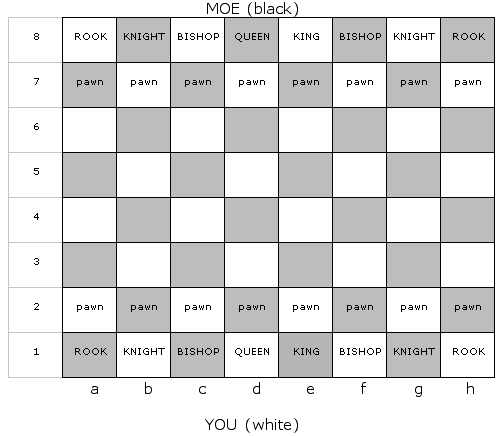
Before we scare you with scary chess terminology, heed our warning: chess players are weirdos. And not normal weirdos, like the people who talk to you at the bus stop, even though you are obviously not going to respond. Chess players are proud to be among the weirdest souls on earth. Case in point: you're not allowed to refer to the rows and columns on a chessboard as a "row" and a "column." You must refer to them as a "rank" and a "file." (Perhaps the vocabulary makes them feel mysterious and dangerous.) Here are two clues to remembering which is which: 1) think of a file like a single file line, which you usually think of as front-to-back, which will remind you that the files are the columns; 2) just remember that "row" and "rank" both begin with an R.
And just in case things weren't complicated enough, each rank has a number and each file has a letter, so that everybody can follow what's going on. For example, your knight is in box b1 (you have another one in g1). Moe's king is on e8. You always list the file, then the rank. If you find this difficult to remember, think of the game Battleship: you call out "B3," not "3B."
2. KNOW HOW THE PIECES MOVE
You set up the board. You're pumped and raring to go. You may have even taken a break to grab a cheese sandwich. But now it's time to buckle down and get serious: we're gonna talk about how each piece is allowed to move. Every piece has different rules about how it can move. But first, keep in mind that only one piece can ever be in a square at a time. So if you want to put your piece in a square that already has a piece in it, you have two options:- If the piece in the square is yours, you have to move it out of the way before you can occupy it.
- If the piece in the square is Moe's, then you can "capture" his piece. Don't say that you "killed" or "got" or "thrashed" Moe's piece. Moe's already in enough pain. Instead, be a classy chess player and say that you captured his piece. You then put your piece in the box on the board, take his piece off the board, and trimphantly place it next to you. That piece is now out of play forever.
So we will now provide you with the rules of how each piece can move: the rook, the bishop, the queen, the king, the knight, and the pawn.
The Rook
The rook is very easy: it only moves up and down, or side to side. It can't go diagonal or sideways or anything else except along a rank or file. It is not allowed to jump over any pieces. The chessboard below shows how a rook is allowed to move. This shows ONE move. If you want to move the rook from c4 to e6, you'd have to first move the rook from c4 to e4, and then on your next turn from e4 to e6. This goes for all pieces: whatever the piece's rule, it lasts one turn.
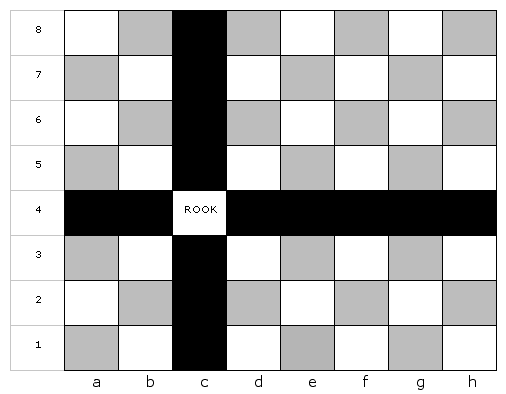
Well, actually, there is ONE time when the rook is allowed to jump over another piece. But don't worry about that sitchy-ashun until you get to the special moves section of this article.
The Bishop
The bishop can only move in a diagonal line for as many spaces as it likes until something blocks it. It also cannot jump over any other pieces during its move. Since bishops only move in diagonal lines, they'll always stay on the same color square that they started on (one starts on a black square, and one on a white). If at some point in the game, both your bishops are on white squares, somebody screwed up. The chessboard below shows how a bishop can move and groove.
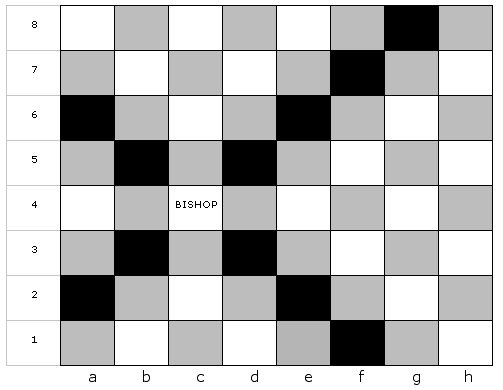
The Queen
The queen is a combination of the rook and the bishop: it can move as many spaces as it likes along a rank, file, or diagonal. Check out all of the ways a queen can move on the board below. That is one cool diva.
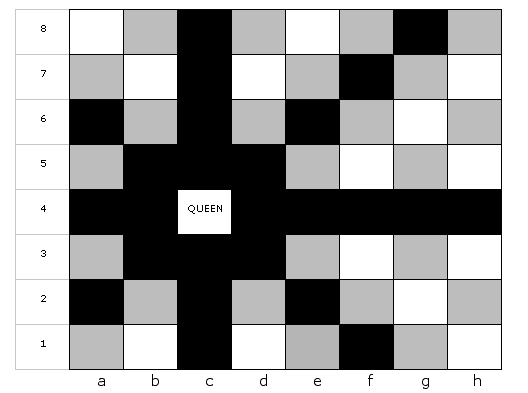
The King
The king is exactly like the queen, except for that like all husbands, he's not as powerful as his wife. He can move in any direction, but only for one box. An example would best explain this:
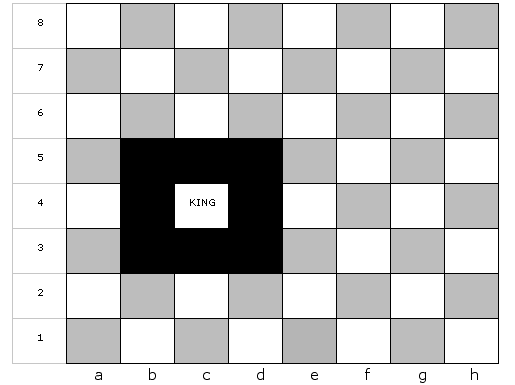
The Knight
OK, things get a little gooey now. The knight can only move in an L-shape. This means that it moves a total of three boxes: 2-straight 1-sideways, or 1-straight 2-sideways. This definitely needs an example. Or lots of liquor:
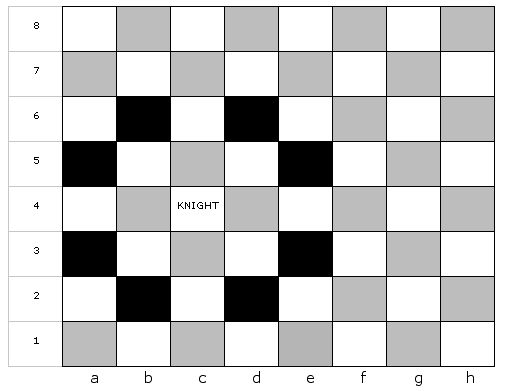
Note how for the knight to move to any one of these spaces, it must moves in an L. For instance, when the knight travels from c4 (where it lies above) to e3, it moves 2 right, 1 down. When it moves from c4 to d2, it moves 1 right, 2 down. It's a bit confusing at first, but you'll get the hang of it. Practice by putting the knight on a board, and visualizing all of the boxes it's allowed to move to.
So you might be thinking "What a sucky piece! It can barely move!" Ah, young fool, that's where you're wrong. Unlike any other piece, the knight is always allowed to jump over other pieces to land in an empty square. It doesn't matter whether it's jumping over yours or Moe's, as long as the knight lands in an empty square, it's legal. This makes it the only "major" piece that you can move without moving a pawn first (a major piece is any piece on the back row), because the knight can jump over the pawns.
The Pawn
The pawns are the first line of defense for your beloved king, but you have so many of ‘em, that an individual pawn is relatively worthless. Pawns are so weak, that they're not even really called pieces. They're just pawns. They're soooooo weak… (how weak are they?…) they're so weak that they can only move one space forward. That's it. They can't move backwards, sideways, diagonal, jump over other pieces, or do anything else fun. Only one space forwards. Poor pawns.
There are THREE exceptions to this rule:
1- If a pawn is coming out of its box for the first time, you have the option to move it either one or two spaces. It's up to you.
2- When a pawn captures another piece, it can ONLY capture it by moving one box forward in a diagonal. It can't capture a piece head-on. Imagine it like this: you're holding a huge shield in front of you. So big, in fact, that you can only stick your spear out to the sides to hit something. See the below chessboard for an example:
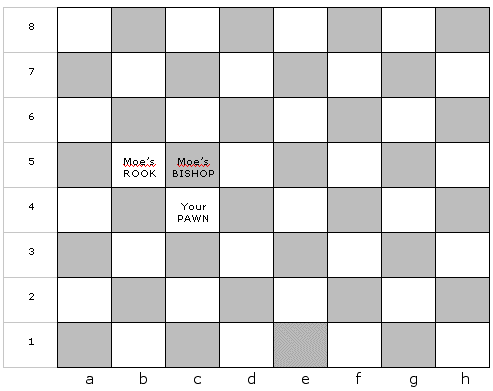
Let's say that it's your turn. Your pawn in square c4 can capture Moe's rook in b5, because it's diagonal from your pawn, only one box away. And just like all captures, you move your pawn to where the captured piece was. This is pretty much the only way for your pawn to get out of its pre-assigned file. But what about Moe's bishop in box c5? Can you capture that? NO. You can't capture Moe's bishop, because it's not at a diagonal. You can't move that pawn forward until the bishop gets out of the way. (By the way, for all of you that think this rules stuff is going too slow, there's a special move that pawns are allowed to make when they get to the fifth row. But don't worry about that until you get to the special moves section.)
3- When your pawn reaches the opposite end of the board, it gets a "promotion." This means that it can become any piece it wants to be, getting that piece's rules, powers, and dental plan. Here's a word of advice: promote your pawn into a queen. Sure, there might be times when the pros decide to not turn their pawns into queens (a strange action called "underpromoting"), but if you are reading this article, then you do not have to worry about such hibbledy-hobbledy. Just promote your pawn to a queen. What's the benefit? Well, now you have two queens on the board! (Or if you lost your queen earlier, you get it back). In fact, if you get every pawn to the opposite end of the board, you can have nine queens on the board at the same time (the original plus the eight pawns).
3. LEARN THE POINT OF THE GAME
Phew! We're pooped. Over 2400 words, and we haven't even gotten to the point of the game yet. But it gets a lot sexier now. It's time to learn how chess players mate like the wild jungle animals they are.
The point of the game is simple: Move your pieces around so that no matter where Moe tries to move his king, it would get captured. It's all about trapping the king. Pretty revolutionary, huh? (Get it? King? Revolution?)
'But before you capture Moe's king, you have to at least be polite enough to give him a warning. Chess is the game of gentlemen. So there are three different situations in which a king can be threatened: check, stalemate, and checkmate (we told you we'd see some mating patterns).
Check
This is when Moe's king is being threatened. When you move one of your pieces so that it would capture the king unless Moe did something about it, then you get to say "check." Not "Czech," not "check… you bastard!" and you may not sing a little song such as "check-a-leck-a-leck-a-leck." Unless your opponent does it to you first. Then you can yell at each other all you want. Look below to get a better example.
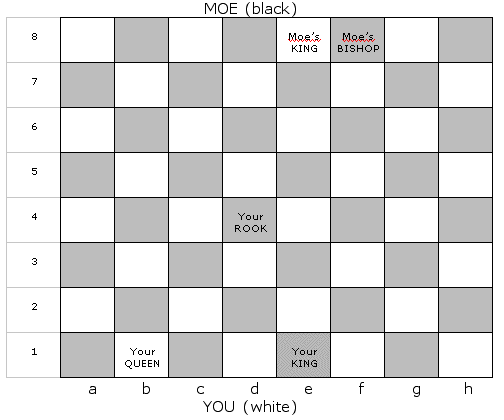
Let's say that it's your turn to move, and you decide to move your queen from b1 to e4 (because your queen can go in a diagonal). Then the board would look like this:
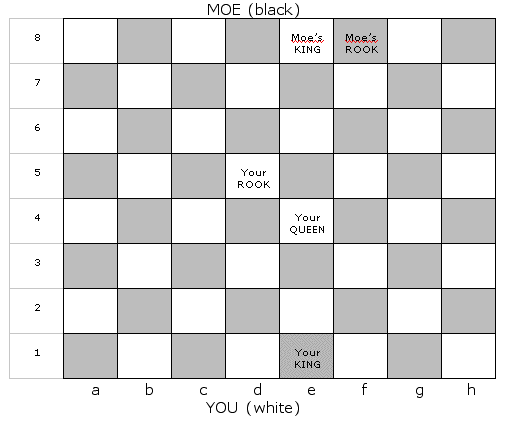
See how your queen can now move right down the file and get Moe's king? If Moe doesn't do something to defend his king, he would lose the game. So that means that his king is in "check." So go ahead and say "check, Moe." What are Moe's options? He can either find a way to capture your queen (eliminating the threat at the source), or he can make a defensive move by either moving his king to a safe square, or putting another piece in front of his king (thus, making a sacrifice). So which of these choices does Moe have? Lesee… he can't capture your queen… he can't move a piece in between his king and your queen… so his only option is to move his king to a safe square. What square would that be, keeping in mind that the king is only allowed to move one square? Well, he can't move his king to e7, because the queen is still there. He can't move it to d8 or d7 because then he'd be moving his king to a place where your rook can get it on the next move (this is known as "moving your king into check," and it's against the rules). So the ONLY choice Moe has is to move his king to f7.
OK, so that was mostly example. All that you have to remember is that "check" happens when a king is under attack, and the owner of said king MUST do something to protect his majesty: either capture the attacker, block the attack with another piece, or move the king.
Checkmate
Now checkmate occurs when the king is in check, but has no way to escape it. Look at the board below, and see if you can understand why Moe's king is in checkmate:
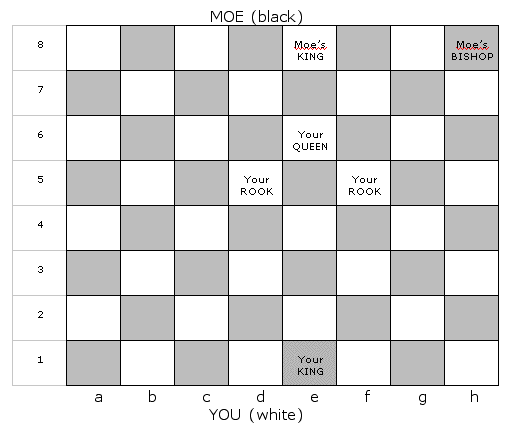
Do you see it? No matter what Moe does, his king will always be in check. If he moves his king anywhere, it'll still be under attack by a rook or the queen, and his bishop can't capture or block anything. The game is over. You win! NOW you can sing and dance and taunt your opponent until (s)he cries violently. Getting checkmate is the ONLY way to win a game of chess.
Stalemate
Stalemates suck. Basically, they're kind of like tie games. It's when your king is in a safe square, but if you move out of it, then your king gets captured. Since you're not allowed to pass a turn in the game of chess, a stalemate is declared. Look below to understand a little more:
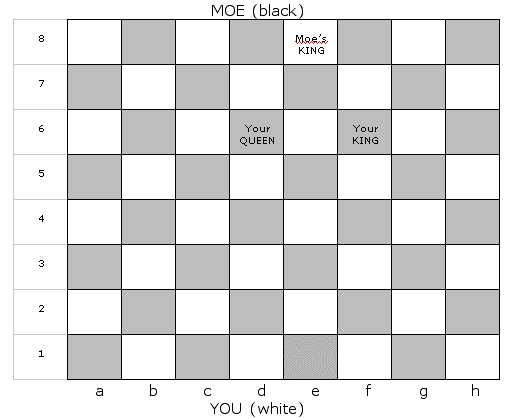
Let's say it's Moe's move. He has nowhere to move! If Moe moves his king to d8, d7, e7, or f8, your queen can capture his king. If Moe moves his king to f7, then your king captures his king. But Moe is safe where his is, right? So a stalemate is declared.
4. GET SOME STRATEGY
Now that your eyeballs have dried out from reading pages and pages of chess rules, we can provide you with a couple of strategic tips.
Know the values of the chess pieces
Some pieces are better than others because they can do more stuff. Queens, for instance, do a lot more than bishops. So follow this guide to know the value of each piece: pawn-1, knight-3, bishop-3, rook-5, queen-9, king-1,000,000,000.
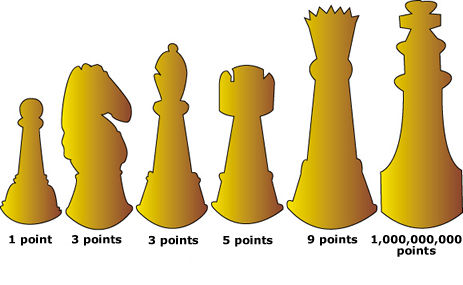
Knowing these values are important, because now you know that if you have to decide between losing a pawn or a rook, you're better off losing the pawn. Trade-offs happen all the time in chess, so knowing the values give you a better sense of what is worth losing (it's often worthwhile to lose your bishop to get your opponent's rook).
Get control of the center squares
The middle four squares on the board (d4, d5, e4, and e5) are the most important squares on the board because they let you control everything that's going on. So grab control of these squares.
Don't expose your good pieces too early
You don't want to risk losing a queen or rook early on. They're too darn valuable. So take your time in taking them out of their homes
Knights are good for attacking
Because knights can jump over pieces, they make for good attackers. So don't be shy about bringing them out early. They're usually the first major pieces that a player will bring out of the back row.
Cheat
Just kidding. Don't cheat. Unless you know you can get away with it.
Think teamwork
Don't just move a piece for the sake of moving it. Have a plan, and think about the repercussions of moving a particular piece. Will it make other more valuable pieces vulnerable? Will it actually do any good? The secret is that very rarely will a piece do anything by itself. Always think of your pieces as being part of your team. So don't just start moving pawns randomly; move them so that they protect each other (if your opponent captures your pawn, you have a pawn that can capture the capture-er).
Practice
It's very important that you practice as much as possible, as well as read as many chess books as possible. Once you've started playing enough, you'll naturally start to see patterns emerge. You won't even have to think about how a piece moves.
5. LEARN SOME SPECIAL MOVES
If you are an advanced player and you've waddled all the way through this article looking for some advanced tips, we have some bad news for you: you won't find it here. This is an article for beginning chess players, and frankly, we're disturbed that it took you this long to figure it out. But for those who have learned the basics and are ready to add a little fire to the arsenal, here are some special moves to learn.
En passant
Zees ees French for "in passing." Ooh, la la, Pepe Le Pew, Jaques Cousteau. OK, enough of that. En passant is a special way for you to capture Moe's pawn. This is exactly how it always works:
- You have a pawn in the two spaces away from Moe's original pawn line-up (in other words, your pawn is in row 5).
- Moe moves a pawn TWO spaces so that it is in the square right next to your pawn.
- When Moe moved his pawn, it passed through a square in which if it had only moved one space, you could've captured it. So we pretend that he did only move that pawn one space, and you take his pawn, moving one square diagonally forward, just as if it had been a normal capture. See below for an example:
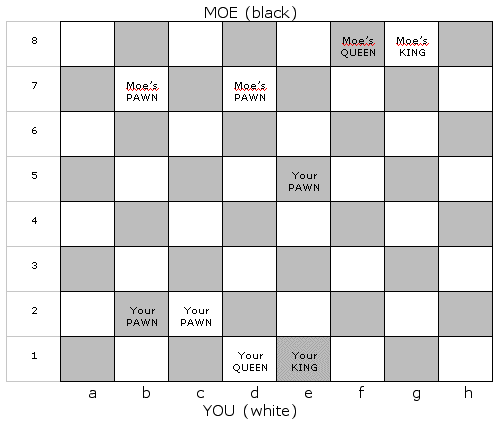
Take note of how your pawn is in the 5th row. Now if Moe moves his pawn from d7 to d5, it has to pass through d6, where you might have had the opportunity to capture it. So if you want, you can capture that pawn, even if he moves it to d5. Look below:
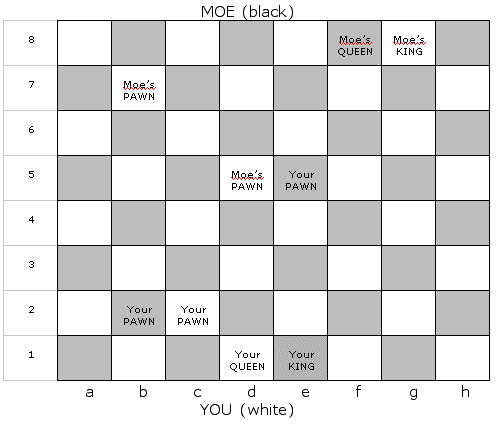
Moe moved to d5…
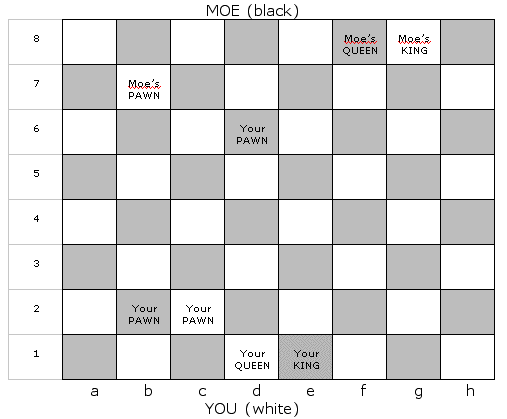
And thanks to en passant, you captured his pawn, and you moved your piece as if Moe had only moved his pawn one space. Cool, huh?
But there is a limit to this rule: if you're going to take Moe's pawn after he moved it out two spaces using en passant, you have to take it on your next immediate turn. You can't move other pieces, and then later just take his pawn away when it's directly next to yours. Of course, if Moe only moved his pawn out one space, you can attack diagonally and capture it whenever you like (unless he captures yours first).
Castling
Castling is a very useful way to protect your king and confuse your opponent, and it is also the only time you are ever allowed to move two pieces at once. It works like this: when your king and a rook (it can be either one) both haven't been moved out of their home boxes for the entire game, you move your king two spaces towards the rook, and then move the rook to the opposite side of the king. Got that? No? Well guess what… we've got another example. Let's say that it's your move and your pieces are set up as below. You're nervous that your king is so vulnerable and you want to protect it.
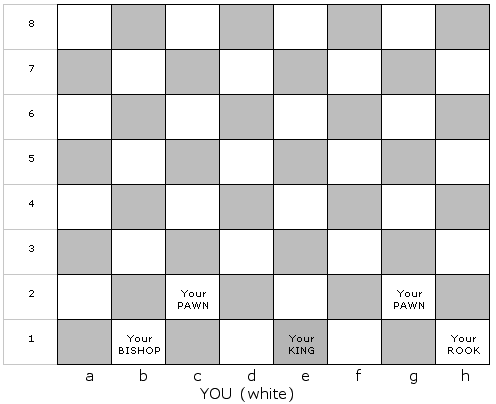
So by castling, you are allowed to move your king two spaces right (toward your rook) and move the rook around to the king to the space next to it, as below:
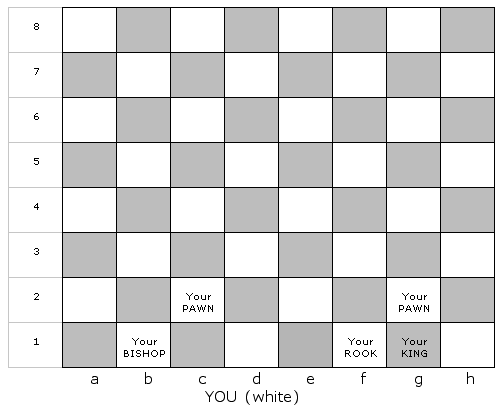
Get it? The king moves two spaces towards the rook, and the rook goes right next to the king, but on the opposite side that it started on. And voilá! You can also castle this way, from here…
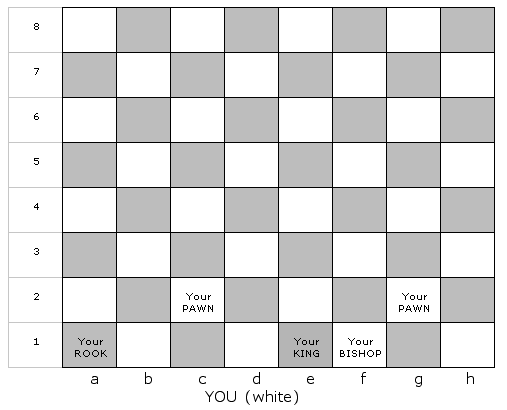
to here:
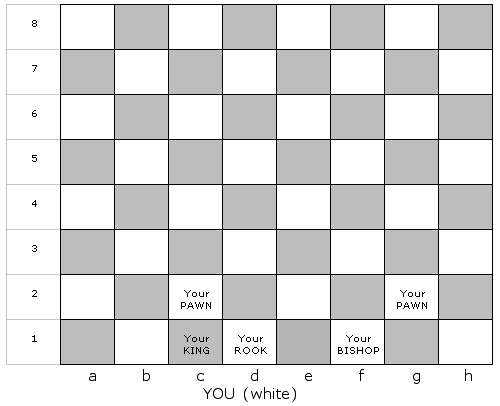
At the risk of sounding repetitive, you moved your king two spaces left, and moved the rook around to the box right next to it on the opposite side of where it started. By the way, the proper way of castling is to move the king first, and then the rook.
Well, we are exhausted. Yes, chess has a lot of rules, but once you get by them, you're pretty much living easy. So good luck, and again, practice practice practice! P.S.- If you end up sucking at chess, just try mastering poker! Play at Americas Cardroom - get the free Americas Cardroom poker download courtesy of AmericasPokerBonusCode.com.


